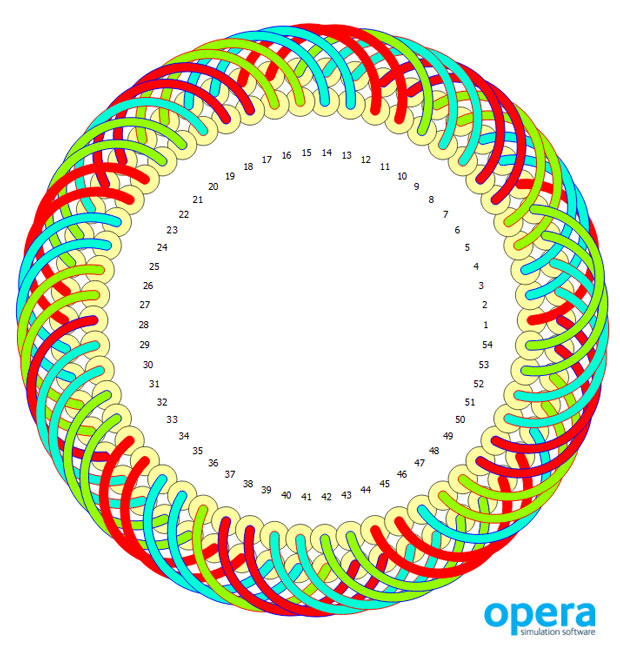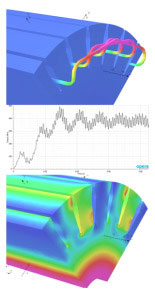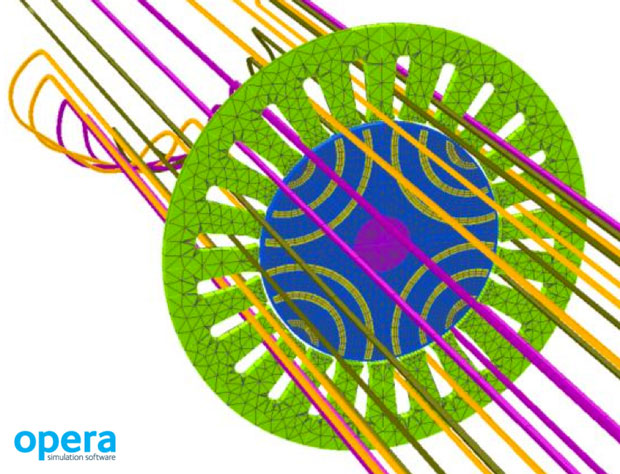
Opera version 18 introduces a new Winding tool that enables users to assess different winding configurations in rotating electrical machines. Image courtesy of Cobham.
Latest News
August 12, 2015
Cobham has launched version 18 of Opera, its suite of electromagnetic and multiphysics design software. A general-purpose finite element analysis (FEA) suite for the design and optimization of electromagnetic devices in two or three space dimensions, Opera 18, says Cobham, incorporates many enhancements that boost functionality, speed and accuracy as well as improve ease of use.
 Opera version 18 introduces a new Winding tool that enables users to assess different winding configurations in rotating electrical machines. Image courtesy of Cobham.
Opera version 18 introduces a new Winding tool that enables users to assess different winding configurations in rotating electrical machines. Image courtesy of Cobham.Key new features in version 18 include an analytic tool for assessing different winding configurations in rotating electrical machines and a graphical analysis setup tool that brings drag-and-drop editing simplicity to complex evaluation sequences involving multiphysics simulation. Additionally, Cobham reports that modeling materials with very small skin depths is simpler with a new surface impedance boundary condition for transient electromagnetic analysis.
Cobham says that Opera’s new Winding tool can shorten development times significantly by allowing highly detailed investigations of possible winding options prior to FEA and simulation of the most promising designs. This design tool is described as enabling designers to assess the feasibility and efficiency of different coil winding configurations and their impact on machine performance easily and quickly. It includes a winding wizard that creates a report of all feasible windings for a user-specified range of slots and poles, backed by detailed winding characteristics for each slot-pole combination. The Winding tool is available for both the 2D and 3D Opera design software packages.
 A new Analysis Setup tool that enables users to set up a complete chain of electromagnetic, thermal and stress analysis simulation, with no limit on complexity or sequence, debuts in Opera 18. Image courtesy of Cobham.
A new Analysis Setup tool that enables users to set up a complete chain of electromagnetic, thermal and stress analysis simulation, with no limit on complexity or sequence, debuts in Opera 18. Image courtesy of Cobham.The Opera-3d Modeler’s new graphical tool reportedly simplifies the preparation of data for analysis. The tool, says the company, provides users with a convenient means of controlling the sequence of analyses using drag-and-drop editing to add or remove specific analysis stages to a list. The tool’s context sensitivity provides instant visual feedback on the validity of requested changes. Users can adjust the properties and parameters of analysis stages within the tool’s environment, and they can save individual analysis stages for use in other sequences.
Cobham says the new Analysis Setup tool simplifies advanced multiphysics simulation, including transient analyses, significantly. For example, users can now set up a complete chain of electromagnetic, thermal and stress analysis simulations with no limit on complexity or sequence. Loops are allowed, and the results from one simulation pass to the next automatically. Users can employ shape deformation caused by forces acting on a model across different types of simulations. The deformed mesh from stress analysis can be nominated for use in subsequent electromagnetic or thermal analyses. When working with coils, the software automatically accommodates any changes in current density values due to shape deformation.
 Cobham says that the “Solve as 2D Slice” feature of the 3D Machines Environment in Opera version 18 speeds solution time by significantly reducing the number of elements that need to be solved. Image courtesy of Cobham.
Cobham says that the “Solve as 2D Slice” feature of the 3D Machines Environment in Opera version 18 speeds solution time by significantly reducing the number of elements that need to be solved. Image courtesy of Cobham.Version 18 of Opera-3d widens scope of the surface impedance boundary condition (SIBC), and it’s now available for use in transient electromagnetic analyses, including demagnetization and motional analyses. Cobham explains that his simplifies the modeling of materials with a very thin skin depth compared to the size of the model by replacing the volume elements in a conducting region with surface elements.
Opera 18 consolidates or extends a number of features that were introduced in earlier versions. Among these are include the “Solve as 2D Slice” feature, which is now standard in the Opera-3d Machines Environment. This enables users to evaluate machine performance using a one element thick slice obtained from the full 3D model, with the appropriate boundary conditions applied automatically. Depending on model complexity this can dramatically reduce the number of elements that need to be solved, the company states.
Opera 18 also extends its optional links to now provide the ability to work with CATIA, NX, PTC Creo and SolidWorks files. IGES, Parasolid, SAT and STEP files offer CAD-neutral geometry access.
Cobham offers Opera 18 in 2D and 3D versions and with a series of analysis modules for specific analyses types, including charged particles, dynamic electromagnetics and motional analyses. Additionally, specialized options are offered for examining specific conditions in more detail than might be feasible with standard facilities and solvers. Among these conditions are quench of superconductors, demagnetization of magnets and magnetron sputtering.
Opera runs on 64-bit Windows and Linux systems. For more details on Opera, visit Cobham.
Check out the new features in Opera 18.
Learn more about Opera’s analysis modules.
Review Opera’s technical requirements.
Take in a webinar (registration required).
See why DE‘s editors selected Opera version 18 as their Pick of the Week.
Sources: Press materials received from the company and additional information gleaned from the company’s website.
Subscribe to our FREE magazine, FREE email newsletters or both!
Latest News
About the Author
Anthony J. Lockwood is Digital Engineering’s founding editor. He is now retired. Contact him via [email protected].
Follow DE





